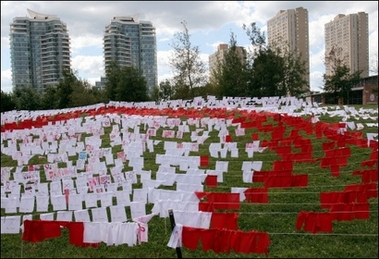TORONTO (AFP) - Outlining its strategic shift in the combat against AIDS,
China has vowed to fight the disease at its source, using innovative measures
that just a few years ago would have been taboo or illegal.
"HIV spreads silently, quietly, without awareness," senior Chinese public
health official Zunyu Wu told the 16th International AIDS Conference in Toronto.
|

Flags representing the eight thousand people
who die of AIDS each day seen near the Convention Centre where the XVI
International Aids Conference is being held, in Toronto, Canada. Outlining
its strategic shift in the combat against AIDS, China has vowed to fight
the disease at its source, using innovative measures that just a few years
ago would have been taboo or illegal.
[AFP]
|
Wu, director of the National Center for AIDS/STD Control and Prevention at
the Chinese Center for Disease Control and Prevention, said that China currently
had a low rate of HIV infection when compared to other countries.
But in terms of raw numbers, a more daunting picture emerged, given the sheer
size of the Chinese population.
Around 650,000 people have the AIDS virus, translating into a rate of only
0.05 percent in a populace of 1.3 billion, said Wu. In 2006, 70,000 more Chinese
contracted the virus, equivalent to 192 per day, according to official
estimates.
"If the rate increases to four percent that would still be low -- but it
would mean 52 million new infections," Wu said.
"The Chinese government is strongly committed to fighting HIV/AIDS," he
declared. "(...) Our goal is that by 2010, China will limit the number of people
living with HIV/AIDS to no more than 1.5 million."
China's first case of AIDS was in 1985 and until 1995 HIV was mainly
restricted to intravenous drug users in the southeastern province of Yunnan,
part of the "Golden Triangle" opium-growing region.
Since then, said Wu, China had experienced two waves of HIV infection.
The first was among people who sold their blood in Henan province in the
1980s and 1990s, getting themselves infected by tainted needles in the process.
"We've almost got this wave under control," said Wu.
The second wave, though, was far different and more
complex. It is spreading among intravenous drug users and increasingly through
sexual intercourse, among gays and through men who visit prostitutes.